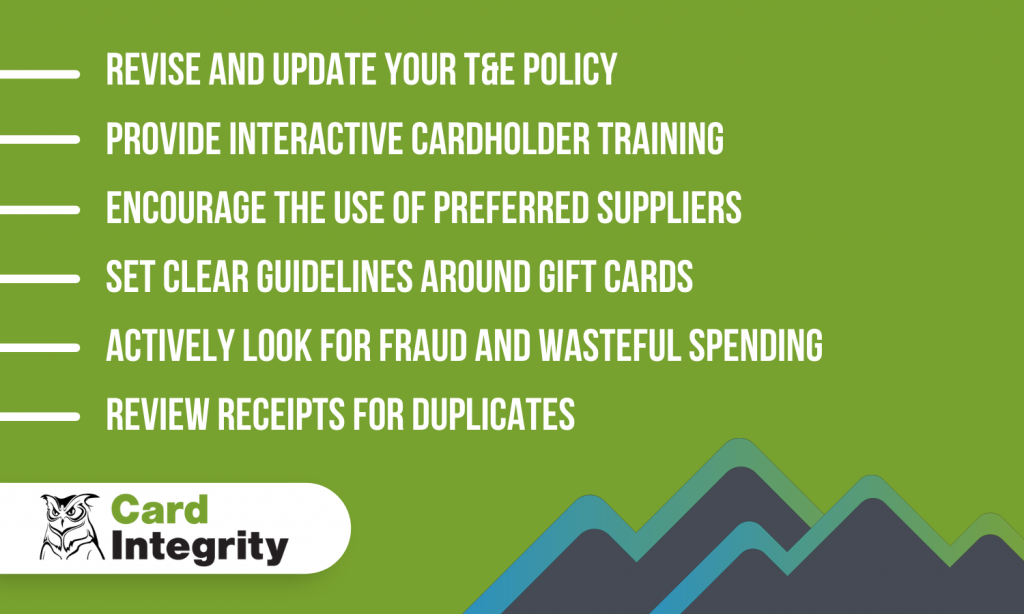
Just as purchasing cards (commonly known as P-Cards) have become a convenient and safe way to handle business expenditures, the more specifically used travel cards (or T&E Cards) have also become popular with businesses as a method of payment. What exactly are travel cards, and what are their pros and cons, especially in terms of monitoring your business expenses?
What is a travel card?
A travel card is similar to a purchasing card, with the only exception being that its use is delegated specifically for travel expenses, often on a global scale. Typically, they are pre-paid cards: a certain amount of money is placed on the card for the cardholder’s use. But it’s also possible to have travel cards that are based on a credit or debit model.
The pros of using travel cards
They help with the management and monitoring of transactions. Because travel cards are being used specifically for travel (as well as dining and entertainment) expenses, they — by their very nature — assist with the organizing and categorizing of expenses. Having these expenses organized in clear, easy-to-view categories makes trends — both positive and negative — easier to track. With use of the data, budgets are better determined, while red flags of fraudulent behavior or misuse become more apparent.
They provide spend control. A handy tool for companies that use cards is the ability to block certain “merchant category codes” (more commonly called MCCs). Doing so helps ensure that the card is used only for its intended purpose — namely travel expenses. Blocking MCCs helps limit misuse and fraud, and it eliminates needless categories when doing expense reviews.
They make tax compliance and deductions easier. The same tools that help transactions more secure and easier to track also help businesses when it comes to taxation. Travel cards make it more convenient to track the T&E deductions and discern tax obligations.
They’re secure. Travel cards offer a secure method of payment. They can be quickly and easily deactivated and replaced if lost, stolen, or damaged. The transactions themselves are safer too, thanks in large part to modern technology — such as chips, PINs, and security monitoring.
Furthermore, some banks also offer other means of security as part of their benefits, such as T&E insurance and emergency travel assistance. When an employee is in a foreign country with limited resources, such added benefits can be extremely reassuring — and they have the potential of saving the company money when such services are necessary. Businesses should check with the bank that issues their travel card to determine if these benefits are available.
They can protect personal credit. One of the great things about travel cards is that they typically do not report credit activity to any consumer credit bureaus. So their usage rarely impacts personal credit lines. Again, check with the issuing bank to confirm whether or not it reports activity to consumer credit bureaus.
They pay — literally. Many travel card companies provide monetary value back to the company via cash rebates, frequent flyer mileage, and hotel points.
The cons of using travel cards
They are limited. While for monitoring and managing expenses this trait is a “pro,” the fact that travel cards are only used for T&E can also be a “con” for some businesses.
Since travel cards are — technically and practically speaking — strictly for travel expenses, this fact creates the necessity of an alternate payment source for all the other types of business expenses. Creating multiple expense payment systems can be challenging for many businesses, as it can place an overwhelming burden on a company’s resources.
They don’t always cover all travel expenses. As ironic as it might seem, there are some expenses that companies with T&E cards exclude that are “travel” in nature. These can include flight upgrades to first or business class, “non-preferred” hotels, car rental upgrades to luxury lines, extra luggage, and memberships for business-lounge access. To prevent confusion on what to purchase with a travel card, companies typically have cardholders comply with a travel policy that will outline the purchases that are prohibited or allowed on the travel card.
They still require monitoring and reviews. Yes, travel cards do inherently assist with organizing expenses. But the key word here is “assist.” The cards alone cannot provide assurance against internal fraud and misuse. Only a stringent system of statement and receipt reviews can do that.
So the assumption that, due to the nature of T&E, monitoring is unnecessary is a dangerous one. Without internal controls, compliance goes unchecked, savings are not realized, and spend categories can become vague, misleading, and downright inappropriate.
Reviewing travel expenses can also be a huge undertaking. Travel cards can carry thousands of data transactions to review. And if your company is still handling reviews manually, that can be a daunting task.
They don’t stop misuse. Travel cards cannot, on their own, stop personal purchases from happening. Nor can they end business purchases that might be out-of-policy, prohibited, or conducted with non-preferred suppliers. Without constant, consistent communication and deliberate training of card users, a greater possibility of misuse on unauthorized charges exists.
That risk of confusion runs for both the travel card and any other methods of payment that might be in use. Without proper orientation of procedures, employees might use the travel cards for non-T&E expenses and likewise, other payment methods for travel.
Another trend worth noting is the extension of business trips into personal travel. Hotel stays and meals that are actually personal in nature can show up on travel card statements. Termed “bleisure trips” (for business and pleasure combined), these trips don’t necessarily have to be condemned — they are often a beneficial perk for employees — provided that the “pleasure” portion doesn’t creep its way onto their travel cards.
Again, monitoring and conducting reviews, with included targeted controls, need to be put into place to keep these transactions from occurring.
They can be pricier. Travel card fees tend to be higher than the typical credit/debit card. There can be fees for:
- Loading and reloading pre-paid cards
- Rate conversion
- ATM usage
- Inactivity
- Cash back at the time of purchase
- Card replacement
- Closing the card’s account
So, to avoid these fees, research a number of financial institutions and their fee structures before choosing a travel card for your organization.
They’re used on a bigger, wider scale. As discussed in our article “Taking on the world: the challenges of a global card program,” the more far-reaching a card program, the more issues that program can potentially face. Namely, these would include the necessity of unique policies and procedures, dealing with international law and compliance, establishing and maintaining good business relationships with international vendors, and reviewing the global spend data. A T&E program will face all these challenges. Click HERE to read and learn more.
Is a travel card right for your business?
So is a travel card right for you and your company or organization? As with anything else in business, you have to weigh the pros and cons — and then decide for yourself, taking into account your organization’s unique wants, needs, and priorities.
But remember when making that decision that Card Integrity can handle the massive, often global aspects of a T&E program. The issues of monitoring all those international transactions, creating and communicating special program policies, and training employees on new card usage are no longer a part of that consideration. Problems solved!
To learn more about how Card Integrity can be an integral part of your travel card program, call us today at 630-501-1507 or contact us by clicking HERE.
For More Tips, Download the Complete T&E Best Practices eGuide
Card Integrity’s T&E card expense review best practices eGuide will provide your organization with a clear and detailed outline of best practices that can be implemented into your program today.




